5 Steps to Selecting the Right Plants for a Rain Garden
http://www.decor-ideas.org 10/01/2015 00:14 Decor Ideas
Plant selection for rain gardens is a real treat, because a rain garden gives you the opportunity to use resilient native plants that you might not otherwise have in your landscape. These plants are uniquely adapted to thriving in dry, moist or inundated soils and can handle varying degrees of water inundation. During a storm, they work with the rain garden’s soil to slow water runoff. Plants are also important because they often are the rain garden’s most visible design element.
This article is the third in a series about rain garden design. First, review how to site and size a rain garden and how to create the right soil mix, and then read on about plant selection.
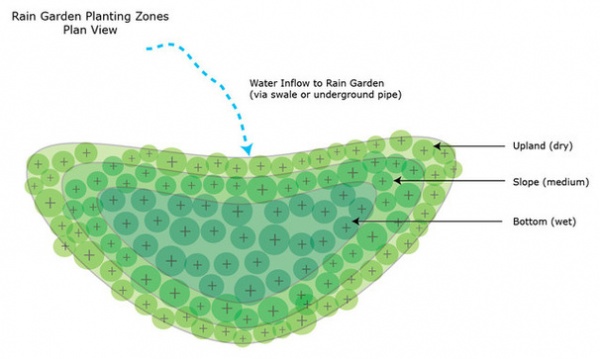
There are many plants that can be used for a rain garden, and it helps to understand the basics on how to zone the rain garden based on moisture and, thus, simplify the task of selecting plants.
1. Divide your rain garden into zones based on moisture level. There are three soil moisture levels in a rain garden, based on how often the soil is wet. The exact amount of time each zone is wet depends on your climate, but here are general rules of thumb:
Bottom (wet): The bottom, or “ponding,” zone will be wet the most, sometimes more than 50 percent of the year depending on your climate, and will have water accumulate during most storms.Slope (medium): The middle zone between wet and dry will be moist about 50 percent of the year, depending on your climate, and will accumulate water only during heavy storms.Upland (dry): The upland, or berm, area of the rain garden will have moist soil only on rare occasions, because water will accumulate there only during extreme rain events.Shown: A plan view of an elliptical rain garden divided into three distinct zones for dry, medium and wet soil moisture.
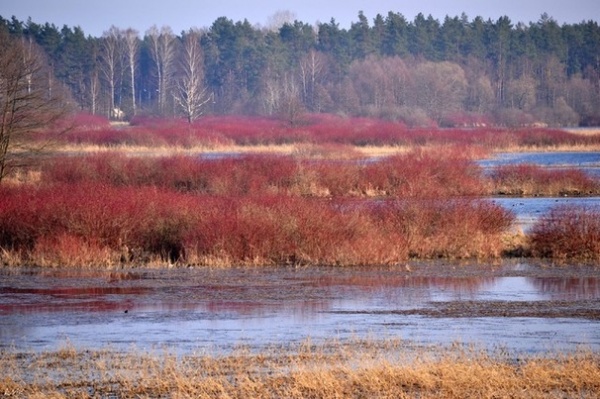
2. Understand how wetland plants are classified based on soil moisture preferences. Plants are adapted to grow based on specific moisture levels in the soil, and many native wetland plants can thrive in varying water levels. Each species can be defined based on how often it is found naturally occurring within a wetland zone. This is called wetland indicator status, and is a way of designating wetland areas based on the plants present. The wetland status of a plant is a key indicator for where it should go in the rain garden. Use the following definitions to help you place the right type of wetland plant in each rain garden zone.
Obligate wetland (OBW): Species of plants that are almost always found living in wetlands. Use OBW plants in the bottom (wet) zone of the rain garden only and intermix them with some facultative wetland plants (see next type). Note that a rain garden does not hold water for more than 36 to 48 hours after a storm, so aquatic plants are not suitable for the rain garden, because they will dry out and perish. An example of an OBW plant with a wide range is the lovely buttonbush (Cephalanthus occidentalis, USDA zones 4 to 10; find your zone).Facultative wetland: Plants that usually, but not always, occur in wetlands. Facultative plants can be used in the bottom (wet) and the slope (medium) zones of the rain garden. Facultative wetland plants are usually the most resilient for the rain garden, because they can survive in varying water levels. A very aromatic facultative wetland plant is coastal sweet pepperbush (Clethra alnifolia, zones 4 to 9). Facultative: Plants that occur in wetlands as well as in upland (dry) areas. Facultative plants are great for use in the slope and upland (dry) zones of the garden. Multiple serviceberry (Amelanchier spp.) species are considered facultative plants. A. alnifolia is one native on the West Coast, and A. arborea is native east of the Rocky Mountains.Shown: Redtwig dogwood (Cornus sericea, zones 2 to 7) growing in a wetland. Redtwig dogwood is a facultative wetland or obligate wetland species, depending on where it is found in its native range.
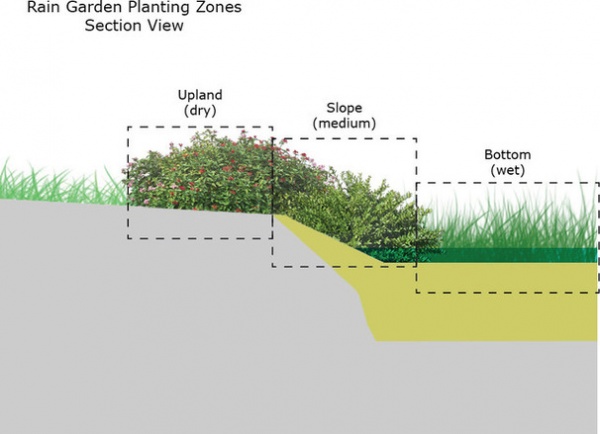
3. Search for native plants using a native-plants database. Finding suitable rain garden plants native to the U.S. is easy with the U.S. Army Corps of Engineers’ National Wetland Plant List. It allows you to search for wetland plants based on your geography. (Select “custom plant list” and use the options to customize for your area.) Additional plant databases include the one created by the Lady Bird Johnson Wildflower Center, where you can search by soil moisture level, and the Missouri Botanical Garden’s Plant Finder, which allows you to select Rain Garden in the Uses list in Advanced Search. Use these databases to search for plant species that are native to your region and thrive within the dry, medium or wet zones of a rain garden. Other resources include your local native-plant societies and government websites that list rain garden resources and plant lists for your area.
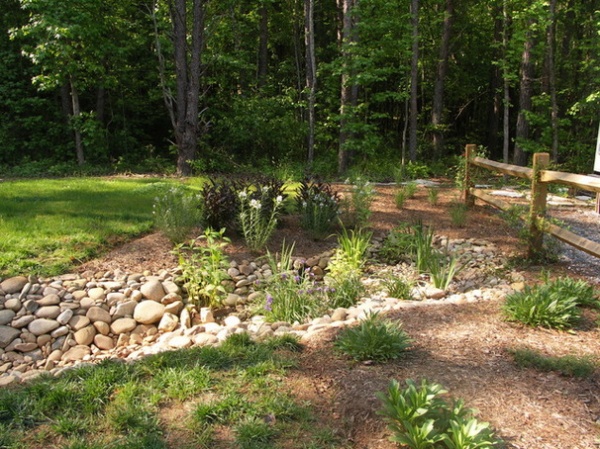
4. Determine how many plant species you will use. Your database search likely will return dozens of plant species suitable for a rain garden. However, your rain garden species diversity may be limited by the availability of native wetland plants in your local nursery.
A rain garden can have as few as three different species — one for each zone — up to as many as you can fit. Work with a local reputable nursery to purchase healthy plants.
Shown (click photo to see the plants tagged): Virginia spiderwort (Tradescantia virginiana), wild bergamot (Monarda fistulosa), Virginia iris (Iris virginica), eastern bluestar (Amsonia tabernaemontana) and ‘Dark Towers’ penstemon (Penstemon digitalis ‘Dark Towers’)
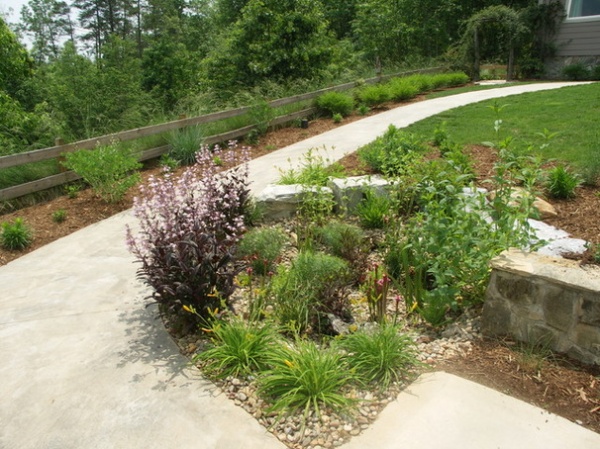
5. Choose plants based on height. The rain garden should grow into a lush and full planting bed for both aesthetic and functional reasons. Functionally, a fully planted rain garden will have greater plant biomass for soaking up and releasing water via evapotranspiration.
One of the best ways to make sure your garden grows in is to layer plants with different heights. Select low ground covers that creep and mound as well as midlevel grasses and shrubs with a variety of forms. Trees can be used in rain gardens, too. Just look for native species that naturally occur in river floodplains — those types can withstand periodic water inundation.
When selecting your plant species, consider how the rain garden will look throughout the year and choose plants that have ecological or aesthetic value in different seasons.
Shown: ‘Husker Red’ penstemon (Penstemon digitalis ‘Husker Red’), sweet pitcherplant (Sarracenia rubra), wild bergamot (Monarda fistulosa) and eastern bluestar (Amsonia tabernaemontana)
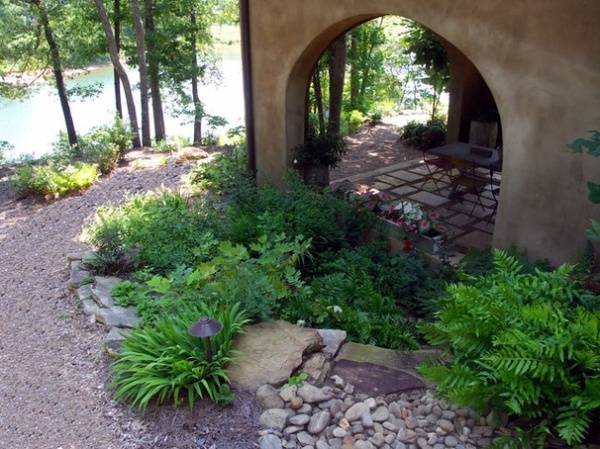
Next: How to get the look you want for your rain garden
More
To Manage Stormwater Sustainably, Understand Your Site
Stormwater Planters Manage Runoff in Small Gardens
More guides to landscape design
Related Articles Recommended












